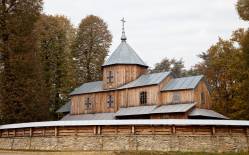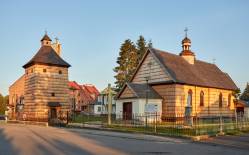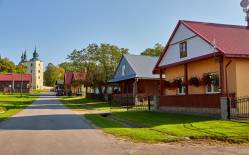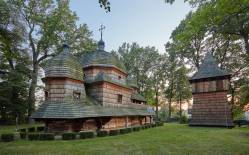Tserkva of Nativity of the Mother of God was built in 1849 at a location of an older wooden church. It was a branch of the Greek-Catholic parish in Stubno. After the Ukrainian population was resettled from here in the 1940s, it was abandoned and later was used as storage for crops. Since 1971 it has been a filial church of the Roman Catholic parish in Stubno.
The tserkva is a log, three-part structure, with a chancel enclosed with semi-hexagonal walls, and with a sacristy adjoining on the northern side. The walls of the nave are slightly higher than those in the chancel and narthex. The building is covered with roofs supported on rafters, and with varied ridge height. Over the chancel there is a five-pitched roof, and over the nave and narthex – two-pitched roofs, while the sacristy is covered with a mono-pitched roof. The roof of the nave is topped with a bell turret. The walls are clad with vertical boards. A skirt roof, clad with sheet metal, runs along the walls in the middle of their height.
The figural and ornamental wall paintings have been preserved inside. The iconostasis from 1900, for some time stored at the Castle Museum in Łańcut, was transferred to a new Greek Catholic tserkva in Mokre.
Near the tserkva there is a wooden post-and-beam belfry built in the mid-1800s. The top story comprises a pseudo-chamber with an open arcade gallery. The belfry is covered with a pyramid roof supported on rafter and king-post truss. The foundation of the structure is clad with a tin skirt roof. All the walls are covered with wood planks.
In the vicinity of Stubienko, within the Stubno Commune, there is a large village of Kalników. This is the only village in Poland where most of the Ukrainian population was not forcefully resettled in the 1940s. This happened owing to the local Roman Catholic priest who issued false certificates of Roman Catholic baptism to all the residents. The village could be saved this way because the authorities carried out the relocations based on the people’s denomination rather than the declared nationality.
Photo: Krzysztof Zajączkowski, Podkarpackie Regional Tourist Board
Gallery
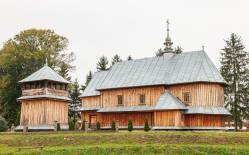
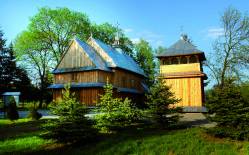
Recommended venues on the Trail



This website has been modernized with the financial support of the European Union under the Cross-Border Cooperation Programme Poland-Belarus-Ukraine 2014-2020. The responsibility for its content lies solely with the Podkarpackie Regional Tourism Board and cannot, in any case, be treated as a reflection of the position of the European Union, the Managing Authority, or the Joint Technical Secretariat of the Cross-Border Cooperation Programme Poland-Belarus-Ukraine 2014-2020.










